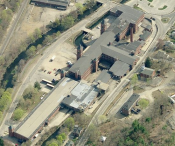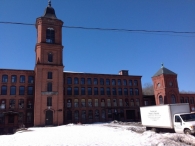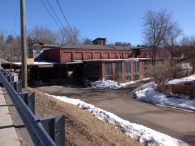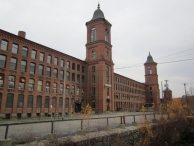Mill Record Thompson
RETURN TO ‘FIND MILLS’Disclaimer: Content for these properties was compiled in 2014-2017 from a variety of sources and is subject to change. Updates are occasionally made under Property Information, however the Connecticut Trust for Historic Preservation (dba Preservation Connecticut) makes no representation or warranty that the information is complete or up-to-date.
- Complex Name (Common)
- North Grosvenordale Mill
- Complex Name (Historic)
-
- Grosvenor-Dale Co.
- Address or Location
- 929 Riverside Drive, Thompson
- County
- Windham
- Historic Designation
- Associated Mill Community
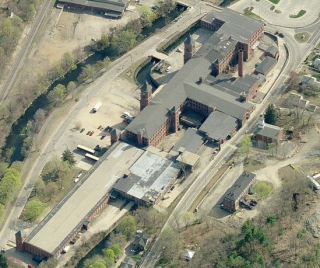 What can you do at this mill?
What can you do at this mill?
- Historic Information
Companies Associated w/Complex
- Grosvenor-Dale Co.
- N Grosvenordale Mill (cotton)
Use (Historic)
Largest Documented Workforce
1750
Historic Narrative
In 1864, two years after completing the 5-story mill in lower Masonville, William Grosvenor purchased the plant and water privilege of the Fisherville Co., about one mile up the French River from Masonville. In 1868, when Masonville was renamed Grosvenordale and the Grosvenor-Dale Co. was incorporated, Fisherville became North Grosvenordale. The company chose the north village for the site of its most ambitious project, building in 1872 the huge Mill No.2 or North Grosvenordale Mill. It is comparable in scale to Connecticut's largest textile mills: Ponemah, Wauregan and Baltic. Like these others, Mill No. 2 was owned by a firm based in Providence and it specialized in finer cottons such as cambrics and high-count sheetings. Four stories tall and 464' x 75', it resembles a brick-pier mill because the segmentally arched windows are recessed in the walls, but there are no pilasters. The cornice is corbeled. There are two stair towers on each long side, at the quarter points. The 5-story west towers are smaller 245 and less ornate than those to the east, which are 6-story with corner pilasters, corbeling between the fourth, fifth and sixth levels, and domed roofs. A 4-story, 135' x 70' brick wing extends west from the center of the mill. The wheelpit beneath the wings held three turbines; the initial installation yielded 400 horsepower, but the masonry dam was raised c.1900 and new turbines installed that provided some 700 horsepower. A steam engine in the attached boiler house generated another 300 horsepower. A 2-story, 90' x 51' ell at the west end of the wing served as the picker house. Outbuildings include the smith shop and waste house in the millyard and two windowless storehouses along the (former) Norwich and Worcester Railroad southeast of the mill. The mill contained 60,000 spindles and by 1882 employed 850 workers. Employment increased to 1,122 in 1890 and 1,750 in 1900, two years after completion of the new weave shed. The high 1-story, brick weave shed originally had a sawtooth roof, which is now flat. (Roth) Swedes worked in North Grosvenordale.
- Architectural Information
Number of Existing Buildings
n/a
Dates of Construction
1872
Architect
n/a
Builder
n/a
Building Type
n/a
Architectural Description
Four stories tall and 464' x 75', it resembles a brick-pier mill because the segmentally arched windows are recessed in the walls, but there are no pilasters. The cornice is corbeled. There are two stair towers on each long side, at the quarter points. The 5-story west towers are smaller and less ornate than those to the east, which are 6-story with corner pilasters, corbeling between the fourth, fifth and sixth levels, and domed roofs. A 4-story, 135' x 70' brick wing extends west from the center of the mill. The wheelpit beneath the wings held three turbines; the initial installation yielded 400 horsepower, but the masonry dam was raised c.1900 and new turbines installed that provided some 700 horsepower. A steam engine in the attached boiler house generated another 300 horsepower. A 2-story, 90' x 51' ell at the west end of the wing served as the picker house. Outbuildings include the smith shop and waste house in the millyard and two windowless storehouses along the (former) Norwich and Worcester Railroad southeast of the mill. The high 1-story, brick weave shed originally had a sawtooth roof, which is now flat. (Roth)
Exterior Material(s)
Structural System(s)
n/a
Roof Form
Roof Material
n/a
Power Source
Condition
n/a
Condition Notes
Easement for deconstruction access between owner and Riverside Acquisition LLC out of North Carolina filed March 2017.
- Property Information
-
Specific Location
between Riverside Drive (route 12) to the west and south and the French River and railroad to the east
Located in North Grosvenordale Mill Historic District (1993).
http://npgallery.nps.gov/nrhp/GetAsset?assetID=7c9f8f26-34c3-4a55-a7f8-56ceec6f4015Adjacent To
Exterior Visible from Public Road?
Yes
Parcel ID / Assessor Record Link
- 167/60/7 / Link →
Acreage
9.44
Use (Present)
- Mixed-Use
- Other: Redevelopment by Camden Mgmt in planning stages as of fall 2017; residential and mixed use. Jan 2020 DECD Brownfield award: $2,000,000 for the abatement of the existing buildings and remediation of soil and groundwater at the former River Mill site for mixed-use, residential redevelopment. 3/31/2025: sale for $10 to River Mill Redevelopment LLD, 4770 S ATLANTA RD SUITE 220 ATLANTA, GA 30339-1557 - this is John Gumpert.
- Vacant
- Sources
-
Form Completed By
n/a
Date
n/a
Bibliography
- Roth, Matthew, et al, Connecticut: An Inventory of Historic Engineering and Industrial Sites (Washington DC: SIA, 1981).
- Representative View(s)Click on image to view full file
